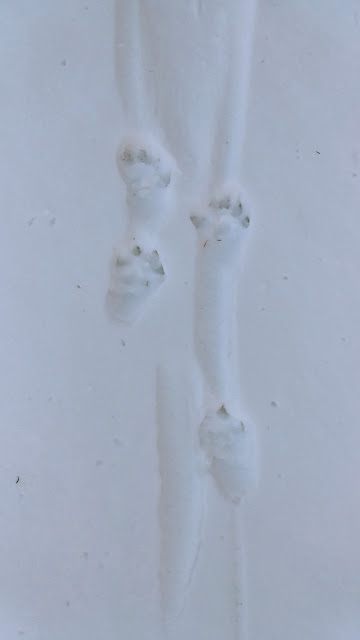I have been watching all winter for signs of river otters out playing in the snow and though I've seen some evidence of their presence around the lake, I didn't see the signs of them having fun out there until this week when a pair of them went across a marsh, all along the shoreline and up and down the banks of the shore where they could take a nice toboggan ride back down to the lake.
 |
| Two sets of tracks show a pair of otters travelling together. |
They would take a few hops to get up some speed and then do a nice belly slide on the snow.
 |
| Note the large tail dragging in the snow. |
The thin snow cover left some good imprints of their tracks.
Otters have partially webbed feet which helps their swimming abilities. They also have five well developed toes which can be seen in the prints above.In all I followed them for half a mile before they went out across the open lake where I lost the track on bare ice with the snow blown off.
 |
| Travelling along the shore, |
 |
| before heading to the open lake. |
Note the uniform 2 by 2 track pattern common to all members of the weasel family when they are moving along at a comfortable pace.
Several weeks ago someone sent me a link to a video of otters playing on a dock that was left in a lake last December. It's not our lake, but it sure could be and it's great example of just how much these animals love to play. You can watch it here.
Otters are rather secretive but I've had a few encounters with them in both summer and winter. Here, a group of four spent some time frolicking in the lake.
On another day a lone otter was as interested in me as I was in him.
They seem more curious than other members of the weasel family. A mink would be gone in a flash and a beaver would slap its tail and dive, though it then might swim back and forth at a safe distance waiting to access wherever it was going. Only an otter would stick its head up and watch me in my kayak.
It was a perfect late-winter day to be out tracking.
The somewhat erratic track pattern, far different from the precise track of a nimble predator like a fox or a bobcat, indicate this is a slower, more plodding type of animal; in this case, a skunk.
 |
| Skunks, racoons, and porcupines don't have the perfect linear track of, for example, a fox. |
Like otters, skunks have fives toes, and if conditions are just right their toenails will leave a mark.
Skunks aren't true hibernators, but they do bed down for the winter, emerging from their dens in late winter to search for food and mates, and males can be quite aggressive fighting each other so they are rather bold this time of year - hikers and dog-walkers beware!
If you're looking for a nice spring excursion, the water is flowing strongly through the waterfalls in Shannon Brook at Castle in the Clouds.
 |
| Two of the seven waterfalls on the Brook Walk Trail. |
But you'll need to go soon if you want to see the ice formations before they melt away (bring some form of traction for your boots).
I'll end with the moon setting behind a cloud bank on Thursday morning, three days before the equinox - spring starts today at 11:33am!











No comments:
Post a Comment